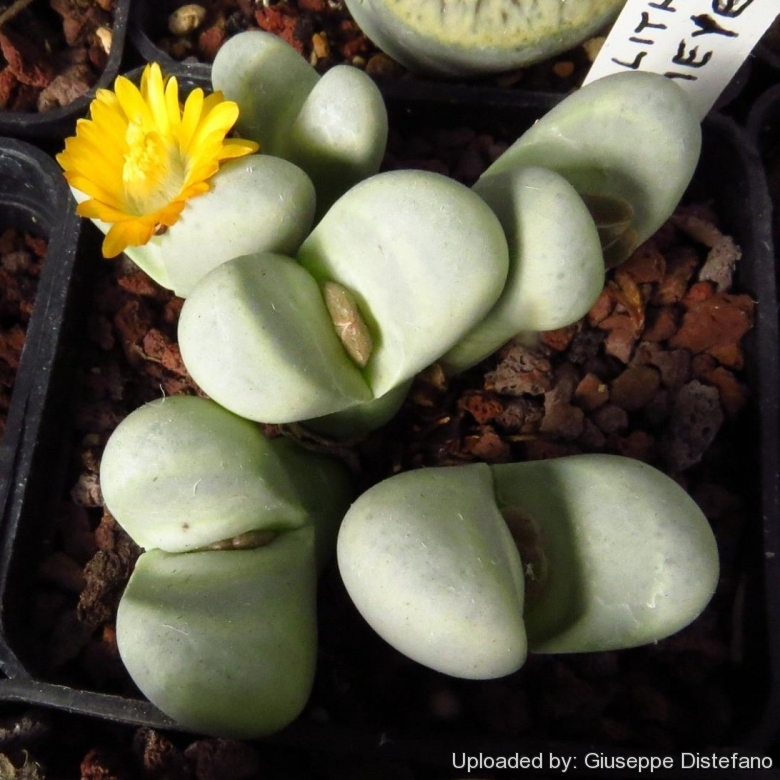
Lithops meyeri Photo by: Giuseppe Distefano
This is one of the more fascinating and intriguing species with milky-grey tones and obscurely perceptible cloudy blue hue.
Origin and Habitat: Endemic to a small area in the Richtersveld, to the north and north-west of Lekkersing. South Africa. TL: Namaqualand: Richtersveld, Brakfontein'
Habitat: Grow in among small quartzite stones. Colours of the background white, with some yellow-brown, brown and black. it is a quartz lover and will always be found growing either on big outcrops of quartz or more commonly on quartz plains where the quartz pebbles protect the plants from the blazing summer sun by reflecting a lot of the light and heat. It closely resembles the white quartz crystalline rubble of its habitat. In times of drought the plants shrivel and are almost invisible, as they get covered with fine wind-blown sand. After rain, however, they absorb water and become fat and turgid.
Synonyms:
See all synonyms of Lithops meyeri
back
Accepted name in llifle Database:Lithops meyeri L. BolusS. African Gard. 22: 102. 1932Synonymy: 4
Cultivars
(1):
back
Description: Lithops meyeriSN|13895]]SN|13895]] is easily recognizable for its almost uniform milky-grey or pale grey-green colour and for the dichotomous leaves that tend to be more spread apart, even when new leaves not growing in. It is a medium species, up to 35 X 24 mm, usually about 27 X 18 mm with up to 5 or more heads (mostly 2-4).
Cole numbers: C212, C272, C273.
Bodies (paired leaves): Characteristically bicuneate, the lobes are disjunct with a deep fissure and distinctly divergent. Profile opaque smooth.
Faces: The top surface is flat to somewhat convex and usually somewhat elevated, often with one side of the face lower than the other. Face elongated elliptic, sometimes slightly reniform; lobes more or less equal. Windows cloudy and only obscurely perceptible. Profile opaque, or occasionally very obscurely transluscent; smooth. Margins indistinctly suffused with somehow lighter colour. Channels, island and rubrications usually usually absent, occasionally visible as indistinct cloudy forms in the windows. opaque pale whitish grey tinged with cream, yellow, milky green or pink. The colour of the margins and face island comprises pale milky-grey tinged with blue, green, pink or cream. Shoulders and inner faces of fissures opaque.
Flowers: Yellow with white centre up to 40 mm in diameter.
Fruits: Capsules 5-6 locular.
Seeds: Light brown.
Blooming season: Flowers appear in late-autumn.
Subspecies, varieties, forms and cultivars of plants belonging to the Lithops meyeri group
Bibliography: Major refences and further lectures
1) Heidrun E. K. Hartmann (2002) “Aizoaceae F – Z” Springer
2) Achim Hecktheuer (2008) “Mesembs, mehr als nur Lithops” Books on Demand GmbH Norderstedt. ISBN-13 978-3-8370-1724-3
3) Desmond T. Cole & Naureen A. Cole, Uwe Beyer, Yves Delange (2008) “Les Lithops” SUCCULENTES Spécial 2008 AIAPS (now Terra seca). ISSN 0258-5359
4) Desmond T. Cole & Naureen A. Cole (2005) “LITHOPS Flowering Stones” Cactus & Co. Libri. ISBN 88-900511-7-5 ISBN-13 978-88-900511-7-3
5) Yasuhiko Shimada (2001) “The Genus Lithops” Dobun Shoin. ISBN 4-8103-4066-X
6) Rudolf Heine (1986) “Lithops - Lebende Steine” Neumann Verlag. ISBN 3-7402-0000-6; ISBN-13 978-3-7402-0000-8
7) Bernd Schlösser (2000) “Lithops – Lebende Steine” Praktische Anleitung für die Zimmerkultur. BussinessPoint MEDIA. ISBN 3-934945-01-5; ISBN-13 978-3-934945-01-2
8) Steven A. Hammer (1999) “Lithops – Treasures of the veld” British Cactus and Succulent Society. ISBN 0-902-099-64-7; ISBN-13 978-0-902099-64-7
9) Desmond T. Cole (1988) “Lithops – Flowering Stones” Acorn Books CC. ISBN 0-620-09678-0; ISBN-13 978-0-620-09678-2
10) Rudolf Heine (1986) “Lithops – lebende Steine” Neumann Verlag. ISBN 3-7402-0000-6; ISBN-13 978-3-7402-0000-8
11) David L. Sprechman (1970) “Lithops” Associated University Presses, Inc. SBN 8386-6902-6
12) Gert Cornelius Nel (1946) “Lithops” Hortors Limited, South Africa
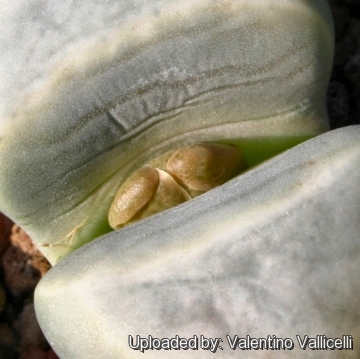 Lithops meyeri Photo by: Valentino Vallicelli
Lithops meyeri Photo by: Valentino Vallicelli Lithops meyeri Photo by: Cactus Art
Lithops meyeri Photo by: Cactus Art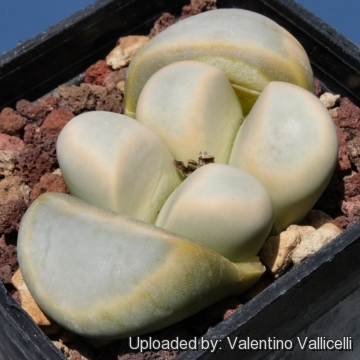 Lithops meyeri Photo by: Valentino Vallicelli
Lithops meyeri Photo by: Valentino Vallicelli Lithops meyeri Photo by: Valentino Vallicelli
Lithops meyeri Photo by: Valentino Vallicelli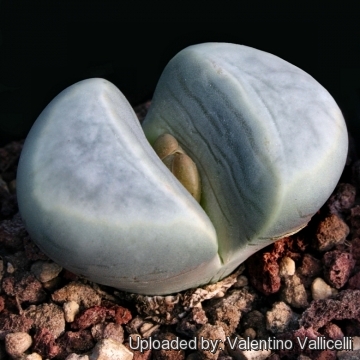 Lithops meyeri Photo by: Valentino Vallicelli
Lithops meyeri Photo by: Valentino Vallicelli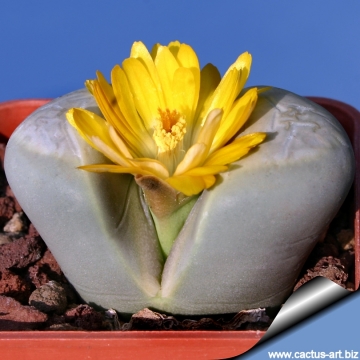 Lithops meyeri Photo by: Cactus Art
Lithops meyeri Photo by: Cactus ArtCultivation and Propagation: Need an open mineral, fast draining mix and the maximum amount of light you are able to give them. The basic cultivation routine is: Stop watering after flowering. Start watering after the old leaves completely dry. (Usually late March or Early April) Water freely during the growing season, soak the compost fully but allow it to dry out between waterings, no water when cold. Some growers fertilize frequently, some hardly ever. Keep them dry during the winter. Nearly all problems occur as a result of overwatering and poor ventilation especially when weather conditions are dull and cool or very humid. This plant is best for a well lit area (Bright shade to full sun).
Your Photos
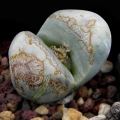
by Valentino Vallicelli

















